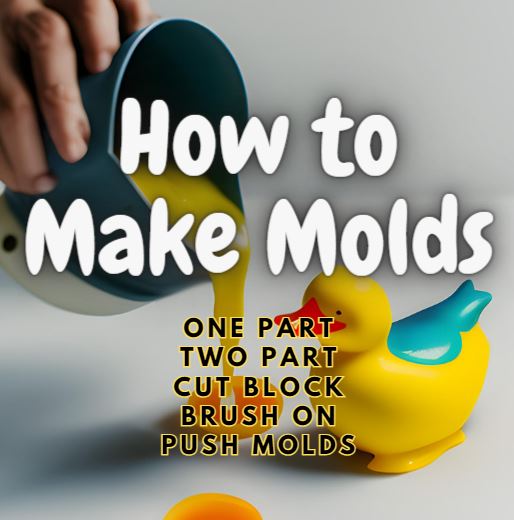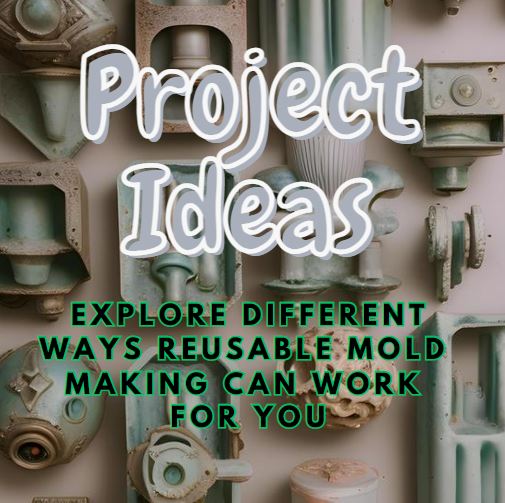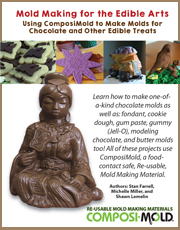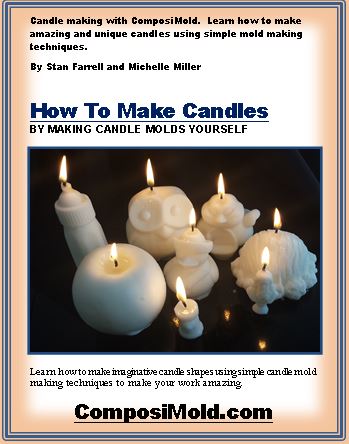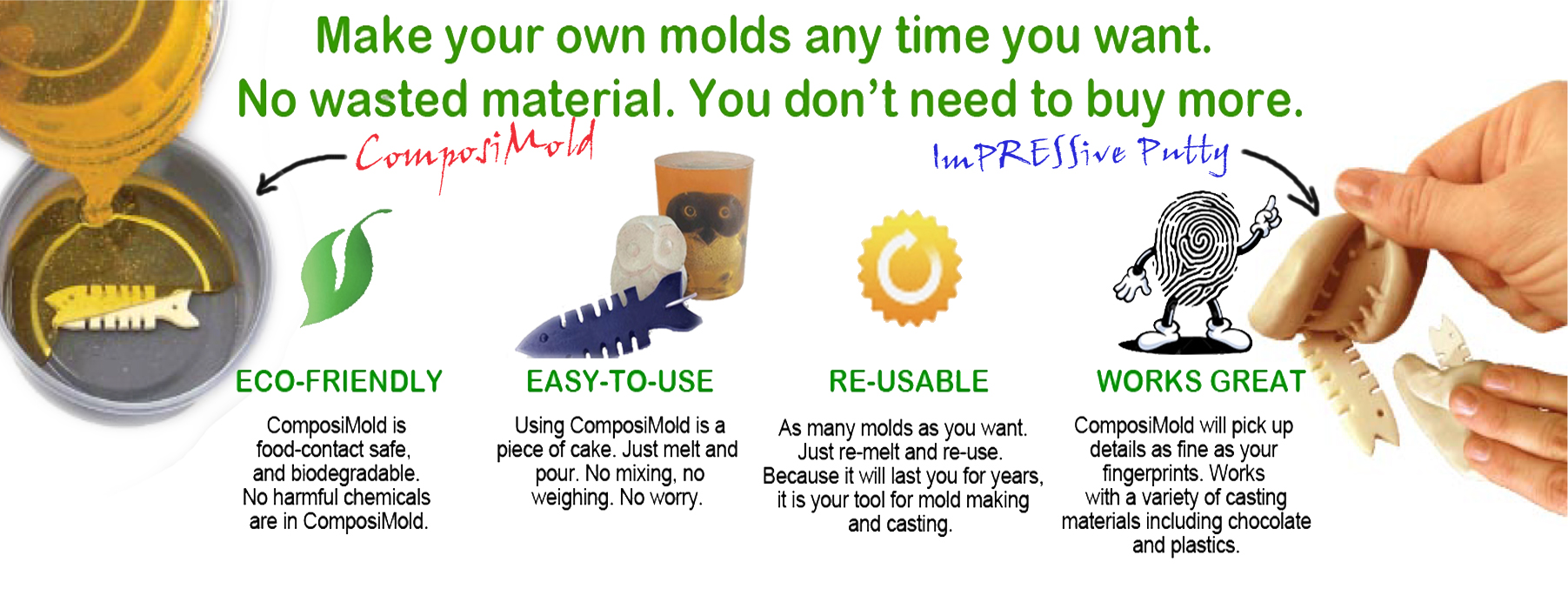
We also have free e-books available. And if you'd like, please sign up for our newsletter for more mold making tips and best practices.
Sign up for our ComposiMold newsletter
Click on the image to open up your free pdf copy of the e-book.
Click on the image to open up your free pdf copy of the e-book.
ComposiMold products provide a way to duplicate your parts cheaply and easily. The re-usable mold making materials allow you to make dozens of molds with the same molding material. The ComposiMold casting materials are designed to work specifically with our molding materials to ensure your success.

Both ComposiMold and ImPRESSive Putty are Re-Usable Mold Making Materials. You can make molds anytime you want: use a little or a lot. Experiment without wasting money or mold making materials. Mold makers will be able to make dozens of molds any time you want.
Unlike silicone molds, latex molds, or other rubber molds, ComposiMold and ImPRESSive Putty moulds are re-meltable and re-usable. When finished you can keep your mold, or make something else-it's your choice.
ComposiMold is:
- 1 Part Mold Making Material (No Mixing or Weighing)
- Food Contact Safe for chocolate molds, fondant molds
- Easy to Use (Microwavable molds)
- Re-meltable and Re-usable Mouldmaking!
- Eco-friendly
- 1 Part Mold Making Material (No Mixing or Weighing)
- Great for Higher Temperature Casting Materials
- Easy to Use Molds (Microwavable Molds)
- Re-meltable and Re-usable Mouldmaking
- Eco-friendly
1. What is ComposiMold, and how does it work?
ComposiMold is a reusable mold-making material designed to create molds for casting various materials. It is a non-toxic, food-safe, and biodegradable material that can be melted and reused multiple times. The process involves melting the ComposiMold in a microwave or double boiler, pouring it over the original object you want to duplicate, and letting it cool to create a flexible, rubbery mold.
2. What materials can be used with ComposiMold for casting?
ComposiMold can be used with a wide range of casting materials, including resins, waxes, soaps, plaster, cements, chocolates (just not after making a resin casting), and more.
3. Is ComposiMold safe to use, and does it have any specific handling instructions?
ComposiMold is generally considered safe to use. It is non-toxic and food-safe, making it suitable for various casting applications. It is hot when melted, so be careful of the heat.
4. Can ComposiMold be used for food-grade casting or other sensitive applications?
Yes, ComposiMold is food-safe and can be used for creating molds of food items like chocolates, fondants, and more. It is also used in various sensitive applications like low temperature soap-making due to its non-toxic nature.
5. How many times can ComposiMold be reused before it needs replacement?
ComposiMold can be reused a lot of times, ranging from 30 to 100s of unique molds,, making it an economical option for mold-making projects. The number of times it can be used for the same mold depends on the complexity of the molds created and how well it is maintained. If the mold shows signs of wear or loses its ability to capture fine details, it may be time to re-melt and re-form it with the same ComposiMold.
6. What is the shelf life of ComposiMold, and how should it be stored?
ComposiMold has a relatively long shelf life if stored properly. It should be kept in a cool, dry place, away from direct sunlight and extreme temperatures. When stored correctly, it can last for several years.
7. Does ComposiMold require any special equipment or tools for casting?
ComposiMold can be melted using a microwave or a double boiler. Other than that, you'll need the object you want to duplicate, the casting material of your choice, and basic mold-making tools like stirring sticks, containers, and release agents (if necessary, and almost always vegetable oil works fine).
8. What are some tips and tricks for getting the best results with ComposiMold?
- Ensure the original object is clean and free from debris or dust.
- Apply a mold release agent and Bubble Buster to the original object to facilitate easy mold release.
- Use support shells or containers to keep the mold in shape during casting.
- Some people like vacuum degassing the casting material to remove air bubbles.
- Experiment with different casting materials and pouring techniques to achieve the desired results.
9. Can ComposiMold be used for both small and large-scale mold-making projects?
Yes, ComposiMold is versatile and can be used for both small and large-scale mold-making projects. It allows you to create molds of various sizes and complexities. You can even use the same ComposiMold for both projects. We’ve made sizes up to a 4 foot tall dog and as small as a sword for a LEGO figure.
10. Is ComposiMold suitable for use with temperature-sensitive casting materials?
Yes, ComposiMold is suitable for use with temperature-sensitive casting materials since it can be melted and poured at relatively low temperatures.
11. Are there any limitations or compatibility issues with certain casting materials?
While ComposiMold is compatible with a wide range of casting materials, certain materials with high melting points may not be suitable for use with ComposiMold. Plus, some urethanes are very sensitive to moisture so can react with the ComposiMold if not protected. Usually, using talcum powder as a mold release provides a moisture barrier for great results.
12. How long does it typically take for ComposiMold to set and cure?
The setting and curing time of ComposiMold is actually just the amount of time it takes to cool to solidify. Cooling can vary depending the ambient temperature and the size of the mold. Place your mold in the freezer or in front of an air conditioner can cool it faster.
13. Are there different types or variations of ComposiMold available for specific applications?
ComposiMold is available in a the ORIGINAL, Food Contact, and also FLEX. All ComposiMold when new is food contact safe. The FLEX is more flexible, softer than the ORIGINAL. More flex helps with softer casting materials like chocolate, soaps, or low melt candle waxes.
14. Can ComposiMold be used for creating molds of complex shapes and fine details?
Yes, ComposiMold can capture intricate details and complex shapes effectively, making it suitable for replicating various objects and designs.
15. Are there any safety precautions or protective measures to consider when using ComposiMold?
Unlike most mold-making material, it’s safe for you as long as you're careful about the heat when it’s melted. It’s non-toxic, environmentally friendly, and economical.
16. What are the alternatives to ComposiMold for mold-making purposes?
There are various mold-making materials available, each with its own advantages and limitations. Some alternatives to ComposiMold include silicone molds, latex molds, and alginate molds.
17. Are there any tutorials or guides available for beginners to learn how to use ComposiMold effectively?
Yes, there are many online tutorials, videos, and guides available that can help beginners learn how to use ComposiMold effectively and achieve the best results in their mold-making projects. All found at the top of this page :)

